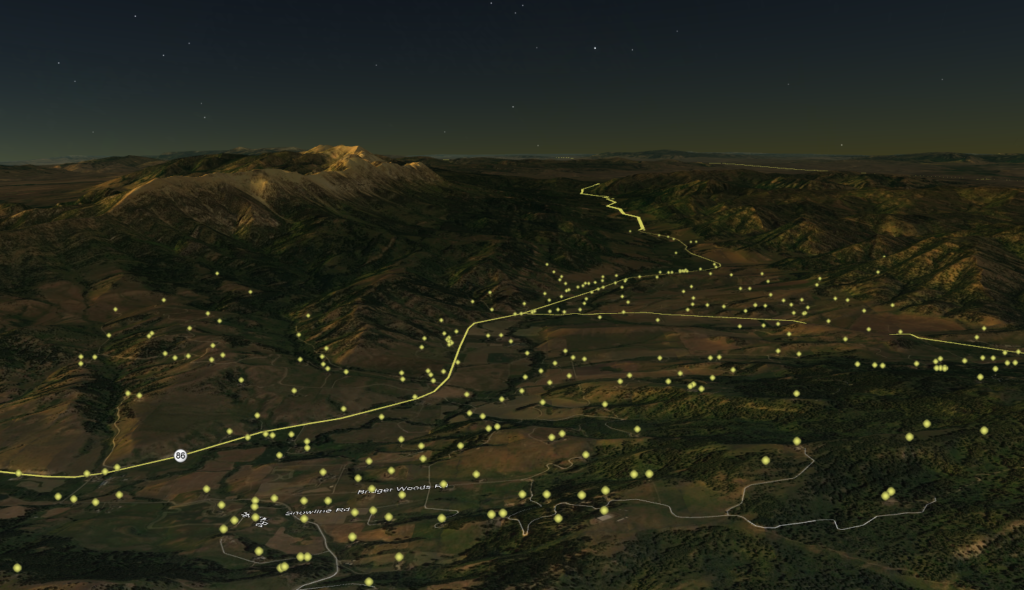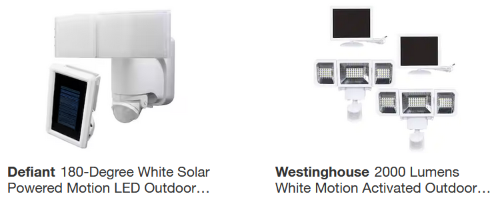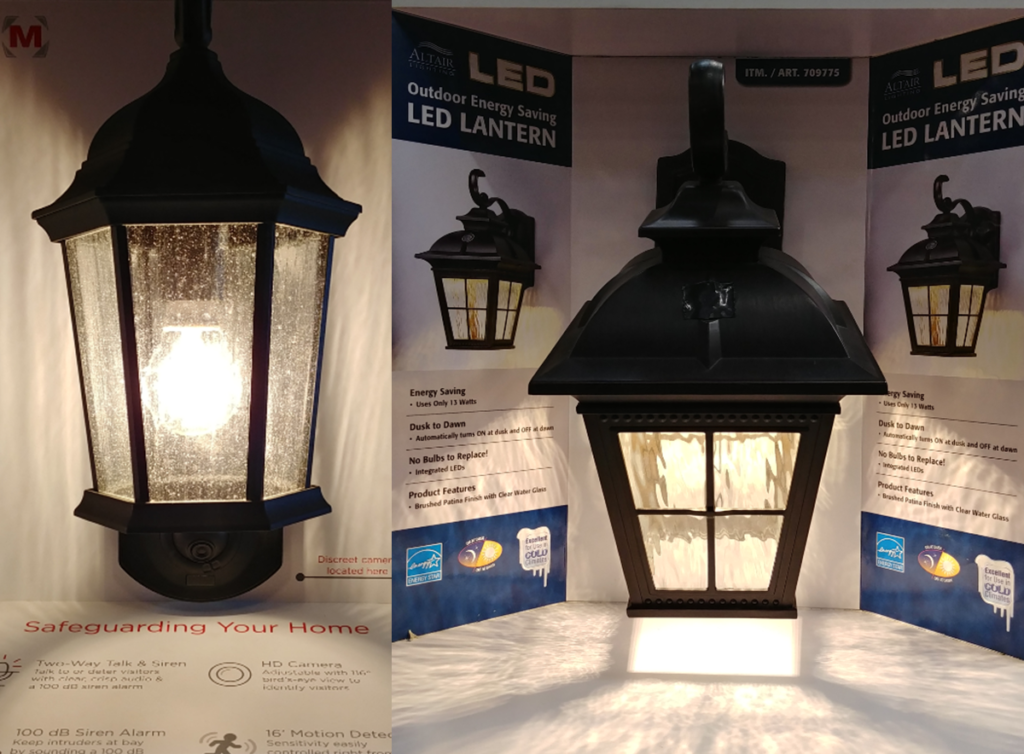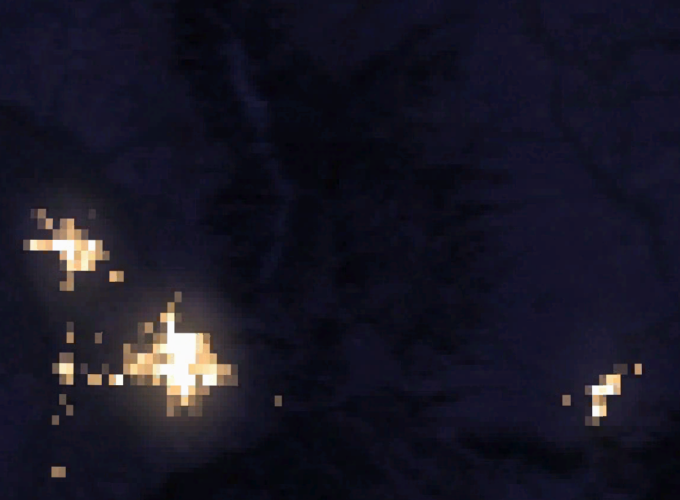BCPOA hears a lot of complaints about light pollution from poorly-directed outdoor lighting – perhaps more than any other issue. We think we can do better, especially if we help each other out with ideas.
We consider this primarily a matter of being good neighbors. However, Bridger Canyon has had a dark skies provision in the Zoning Regulation for decades. The current language is:
12.7 Exterior Lighting. All exterior lighting fixtures shall be designed, constructed, and placed in such a manner to ensure that:
a. Direct or reflected light is not directed off the property.
b. All light sources are shielded. Lighting fixtures shall be downward facing having 100% cutoff. The light rays may not be emitted by the installed fixture at angles above the horizontal plane, as may be certified by photometric test.
c. There shall be no lighting of a blinking, flashing, or fluttering nature, included changes in light intensity, brightness or color. The sole exception to this requirement is temporary holiday lights with no commercial message.
d. Beacon lights are not permitted.
e. Exterior lights may not be left on all night. Motion, heat, or similar detecting switches may be used.
f. No lights may be placed at an elevation higher than the tallest Building on the property.
Background
Part of the problem is the city, which casts an impressive skyglow, to the dismay of astronomers:
However, part of the problem is also … us. Here’s a visualization of Bridger Canyon, with one glowing light at the location of each structure in County GIS data:

Bridger Canyon in the evening, as simulated by Google Earth. Each glowing orb represents a single light at the location of an existing structure.
A lot of lights are well-shielded, or simply off, but some places are illuminated like the Washington Mall. Topography complicates matters, because downlighting is still visible to people downhill, and obviously we have a lot of slopes.
The problem is getting harder, because vendors aren’t using LEDs to improve lighting, they’re just churning out cheap, unshielded junk:
 Lights like this waste half their lumens, and half your money, illuminating the sky. That makes for bad views as well as irritated neighbors and threatened wildlife.
Lights like this waste half their lumens, and half your money, illuminating the sky. That makes for bad views as well as irritated neighbors and threatened wildlife.
What you can do:
If you have a neighbor whose lighting disturbs you:
Your best bet is to talk with them. We’ve heard of several success stories, where people were simply unaware of the impact they were having, and cheerfully upgraded lights, controls, or usage.
If that’s awkward, or they’re not in residence, you might try printing out some resources to place in their mailbox.
To upgrade your own lighting:
This can be a win-win, because reducing light pollution also typically reduces glare, improves views and increases energy efficiency. You’re likely to see more wildlife, and certainly more stars.
If you’re building or retrofitting,
- Ask your builder, designer or architect to spec dark sky-compliant lighting.
- Choose fixtures that are shielded to direct light downward.
- Choose warmer rather than cooler light (red light scatters less than blue in the atmosphere).
- Illuminate just the area needed.
- Use controls, so that lights are on only when needed, rather than all the time (but be aware that flickering motion lights can also be annoying).
- Don’t forget the indoor lighting – the Bozeman Public Library is a nice example of indoor lighting that looks good and stays indoors.
- Pay attention to quantity as well as quality. If you have extensive wall-wash fixtures on your structure, no amount of shielding will help it to blend in. Snow turns down-light into up-light.
Often you’ll find similar fixtures at similar prices, with very different performance. For example, last week at Costco:

Better: The lamp on the right uses the low form factor of LEDs to shield the light source in the hood, so it’s directed down with minimal horizontal highlights.
Worse: The one on the left has a fancy IP camera, but it’s stuck in 1882, with an Edison bulb glaring for all to see.
Something completely shielded would probably be even better, like these:
This doesn’t have to be hard or expensive. Progress Lighting makes a “NightSaver” retrofit snoot for about $15. Sometimes just switching to a directional bulb is enough. Or, you can do-it-yourself:

Here is one of our outdoor lights, painted on the side facing the street/neighbors. Note that all other surfaces are open so lite still goes down, out the backside, and over to our yard where it’s useful to us but doesn’t shine on the neighbors. For this one I used a can of spray paint and a piece of cardboard to shield the wall. – Chuck/Susan Kendrick
Resources:
We’re continuously looking for more resources, but one local name that keeps coming up is Distinctive Lighting.
Longtime canyon resident Bill Costigan contributed the following rich set of links. (Bill founded Poindexter’s in 1987. They have a shop off the frontage road not far from the Subaru dealership – please call ahead to arrange an apt.)
Below are a few resources which I hope will prove helpful to our neighbors in their quest for “dark sky” lighting solutions. With lighting, having a method of controlling or automating the lighting is yet another important consideration.
Depending upon the scope of the project, coordinating with a “designer”, an “electrical contractor” and perhaps a “low voltage specialist” or “integrator” to form a plan on how best to control a lighting system are important considerations for a successful project.
Local Lighting Design Firms: (some of these firms may also offer for sale the products they recommend)
http://ambiance.life/ * designer and integrator
https://www.beartoothlightingdesign.com/ * designer
https://elementslight.com/ * designer
https://poindexters.com/ * designer and integrator
Stand Out Exterior Lighting Fixtures Manufactures, all but WAC distributed by Poindexter’s: * comments provided by Poindexter’s
http://www.arklighting.com/ * Less expensive lighting solutions, build quality reflected in the cost
http://www.baselite.com/ * High Quality Products made in the USA
https://www.bklighting.com/ * Very High Quality Products made in the USA
https://www.barnlight.com/ * High Quality made in the USA
http://www.waclighting.com/ * Good Quality, more modern design style
Stand Out LED Lamp Manufactures: Distributed by Poindexter’s * We have demo fixtures featuring Soraa and Q-Tran at our office.
https://www.soraa.com/ * The nicest looking LED lamps we’ve discovered. A19, MR16, PAR 20,30 and 38 models available. * Some modern interior fixtures also offered.
https://q-tran.com/ * Manufactures of high quality power supplies and Liner LED tape light. / These may be used for indirect lighting applications. Q-Tran makes high quality bury able power supplies and a water proof wiring system for low voltage fixtures
Lowes and Home Depot do have some dark skies-compliant lighting, but you have to seek it out. Much of the selection on display is simply dreadful.

Outdoor floodlights – if they’re on – are some of the worst offenders, and some new LED designs are, if anything, worse – most of these direct almost half their light into the sky.
The International Dark-Sky Association has a lighting primer and many other resources. The Salt Lake City chapter has a particularly good site, too.
Help out:
Let us know your own favorite resources, success stories, etc. via the comment form below.






 Twitter
Twitter Facebook
Facebook RSS
RSS Email
Email